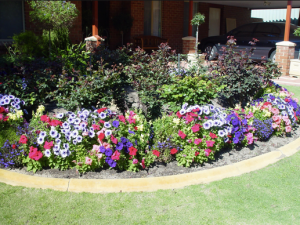As the weather warms up, right now is prime time for prepping your garden, yard, pots and containers for the blooming season. It is also time to visit your favorite local nursery and garden center. Anyone with a green thumb is likely itching to get their hands dirty, but there are only so many plants, bulbs and seeds that are going to thrive if planted right now. Instead, focus on early gardening projects that will help get your home ready for the season while satisfying your urge to get started. There’s more to it than seedlings and soil, plus you’ll get a head start to make the most of your most gorgeous garden yet.
Start by clearing out those drainage ditches—they’re likely full of leaves and muck from the winter. You need to help spring rains get a good runoff, and the best soil is drainable. Early spring is a low grow time for vegetables, making it the perfect season for drain ditch spring cleaning. Create compost when you can, with dead leaves for example, because carbon-heavy soil is something plants can’t resist.
Repair and Reap the Rewards
Survey the garden and see if there are any bowed flower bed sides. Trellises and fencing might also be in need of maintenance. Those snowy, wet winters can do a number on outdoor wood, and when rot sets in a replacement will be in order. However, bowed sides can be fixed with new stakes, and repairs to fences are best done in the spring when there’s little growth to get in the way. Plus, not as many roots are available to be disturbed. Install fence posts later in the season, after the spring rains have drained.
It’s never too early (or late) to start weeding and mulching bald spots. It’s less work to pull weeds right now, since they have shallow roots. Pick up some mulch or ground cover to fill bald spots and prevent new weeds from growing. Putting down plastic sheeting works well as a cover, just as long as you flip it every week to avoid slug infestations. However, be careful when mulching close to beds or near fruit trees, keeping it a few inches away to avoid plant or bark rot.
Almost Ready
Depending on where you live, wait for a dry spell and top dress the gardens with compost or a seasoned manure mix to get ready for planting. Don’t dig it too early; soil ecosystems are complex and best left to “fester” on their own. Don’t worry—any nutrients added to the top dressing will work their way through the soil naturally. It might seem like compost piles aren’t actually “composting,” but looks can be deceiving.
Check the pH balance of soils, and if it’s less than 6.2 consider adding lime to the mix. In a perfect world, this is added many weeks before planting and using it as a quick fix isn’t recommended. It might shift the pH so quickly that the soil and future plants are shocked.
Finishing Touches
Don’t forget about the landscape beyond the garden, and spend a weekend raking dead leaves, which lets air and light get to the soil. This encourages gross growth, and it’s also a great time to re-seed the lawn. Metal rakings before re-seeding is a good idea, and make sure to keep the area watered well, at least until germination.
Finally, prune dead foliage, pull vegetable skeletons and thin ornamentals to encourage new growth. This is a task for the autumn, but if it was put off or another trimming is in order, it can only help. Now comes the best part—deciding what new plants, flowers or shrubbery you’ll be adding this year. Nothing compares to the joy of starting with a clean slate (or, in this case, yard).



